Effective Decision Making in Business: A Comprehensive Report
VerifiedAdded on 2022/02/09
|11
|1794
|27
Report
AI Summary
This report analyzes effective decision-making within the context of SMC Holdings, addressing various business issues such as human resources, technology, regulations, competition, and uncertainty. It identifies stakeholders and their needs, exploring different research methods like descriptive, analytical, applied, fundamental, quantitative, and qualitative approaches. The report details the decision-making process, including problem identification, objective setting, alternative generation, evaluation, decision selection, implementation, and monitoring. It examines rational, behavioral, practical, and personal approaches to decision-making, along with internal and external information sources. The report concludes by highlighting common difficulties in decision-making, such as incomplete information, non-acceptance by subordinates, ineffective communication, and incorrect timing, emphasizing the importance of proactive measures. The report is a valuable resource for understanding and improving decision-making processes in a business environment.
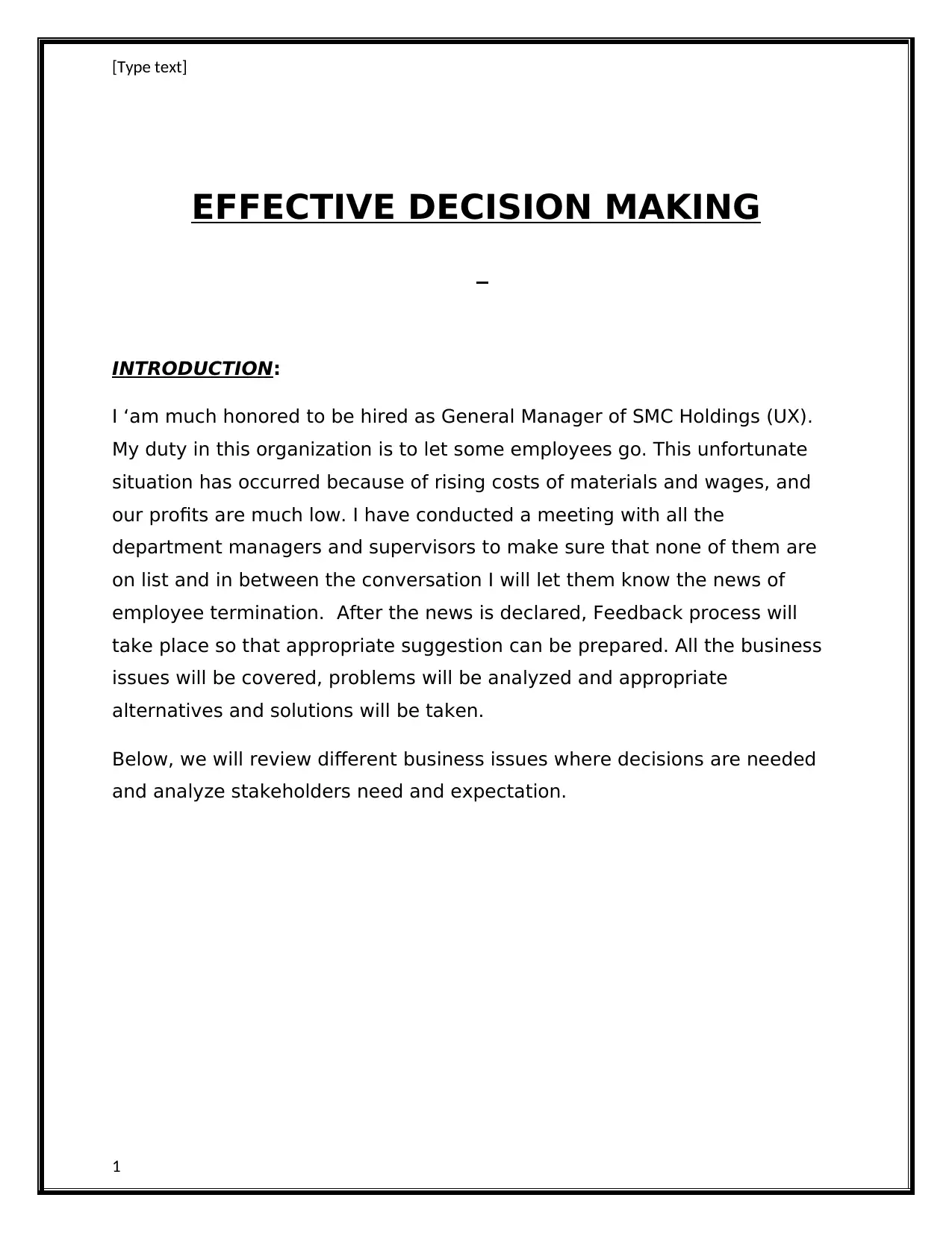
[Type text]
EFFECTIVE DECISION MAKING
INTRODUCTION:
I ‘am much honored to be hired as General Manager of SMC Holdings (UX).
My duty in this organization is to let some employees go. This unfortunate
situation has occurred because of rising costs of materials and wages, and
our profits are much low. I have conducted a meeting with all the
department managers and supervisors to make sure that none of them are
on list and in between the conversation I will let them know the news of
employee termination. After the news is declared, Feedback process will
take place so that appropriate suggestion can be prepared. All the business
issues will be covered, problems will be analyzed and appropriate
alternatives and solutions will be taken.
Below, we will review different business issues where decisions are needed
and analyze stakeholders need and expectation.
1
EFFECTIVE DECISION MAKING
INTRODUCTION:
I ‘am much honored to be hired as General Manager of SMC Holdings (UX).
My duty in this organization is to let some employees go. This unfortunate
situation has occurred because of rising costs of materials and wages, and
our profits are much low. I have conducted a meeting with all the
department managers and supervisors to make sure that none of them are
on list and in between the conversation I will let them know the news of
employee termination. After the news is declared, Feedback process will
take place so that appropriate suggestion can be prepared. All the business
issues will be covered, problems will be analyzed and appropriate
alternatives and solutions will be taken.
Below, we will review different business issues where decisions are needed
and analyze stakeholders need and expectation.
1
Paraphrase This Document
Need a fresh take? Get an instant paraphrase of this document with our AI Paraphraser
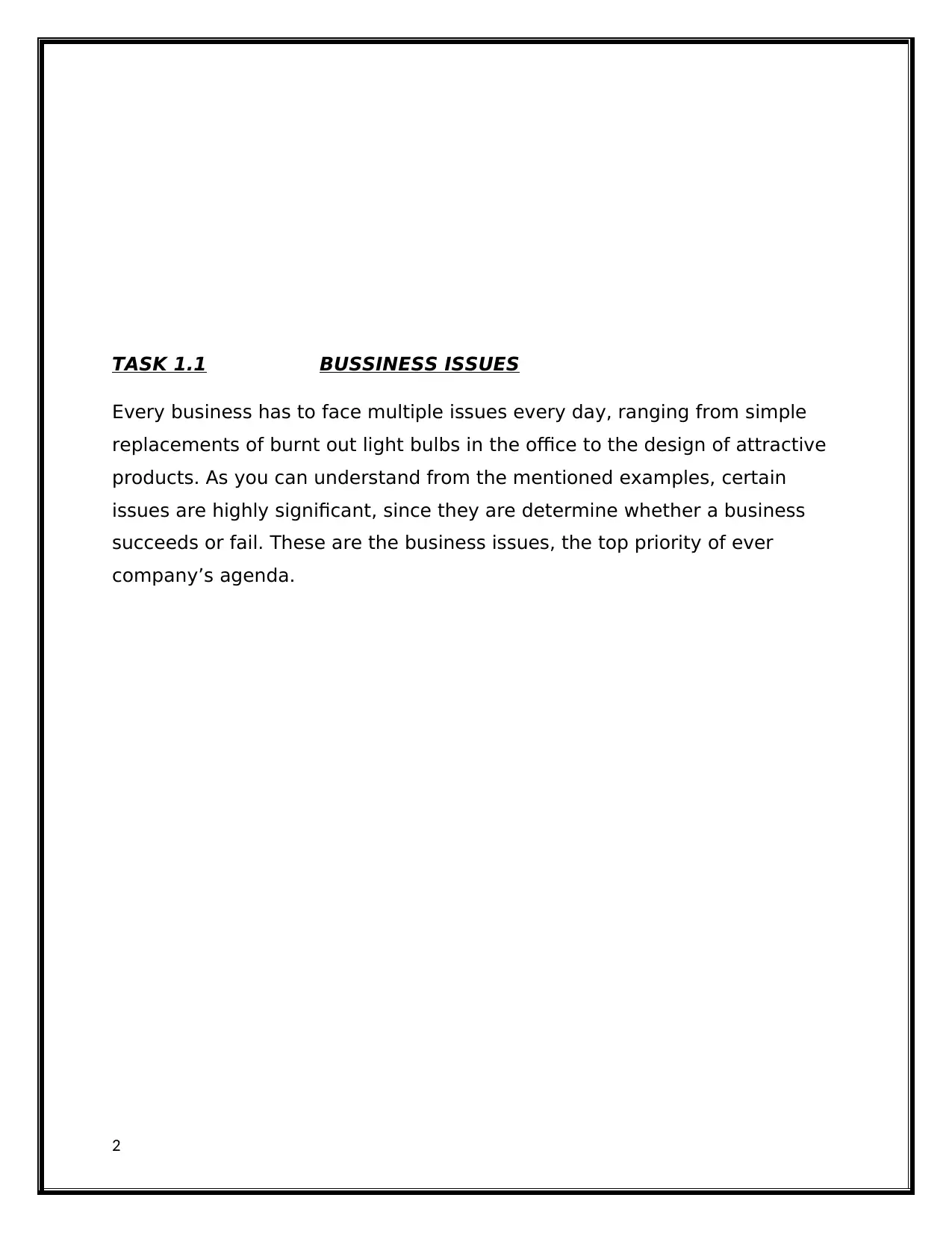
TASK 1.1 BUSSINESS ISSUES
Every business has to face multiple issues every day, ranging from simple
replacements of burnt out light bulbs in the office to the design of attractive
products. As you can understand from the mentioned examples, certain
issues are highly significant, since they are determine whether a business
succeeds or fail. These are the business issues, the top priority of ever
company’s agenda.
2
Every business has to face multiple issues every day, ranging from simple
replacements of burnt out light bulbs in the office to the design of attractive
products. As you can understand from the mentioned examples, certain
issues are highly significant, since they are determine whether a business
succeeds or fail. These are the business issues, the top priority of ever
company’s agenda.
2
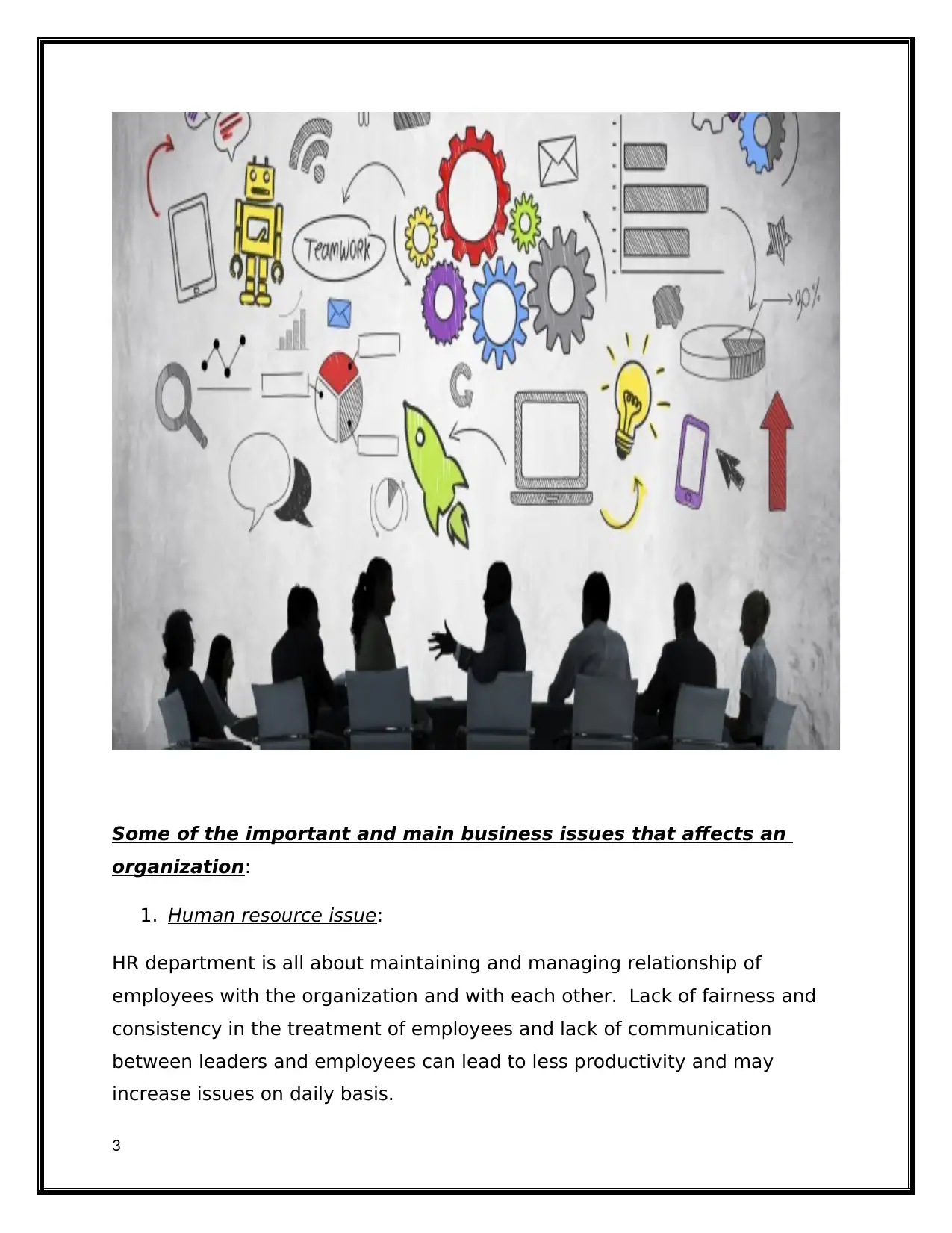
Some of the important and main business issues that affects an
organization:
1. Human resource issue:
HR department is all about maintaining and managing relationship of
employees with the organization and with each other. Lack of fairness and
consistency in the treatment of employees and lack of communication
between leaders and employees can lead to less productivity and may
increase issues on daily basis.
3
organization:
1. Human resource issue:
HR department is all about maintaining and managing relationship of
employees with the organization and with each other. Lack of fairness and
consistency in the treatment of employees and lack of communication
between leaders and employees can lead to less productivity and may
increase issues on daily basis.
3
⊘ This is a preview!⊘
Do you want full access?
Subscribe today to unlock all pages.

Trusted by 1+ million students worldwide
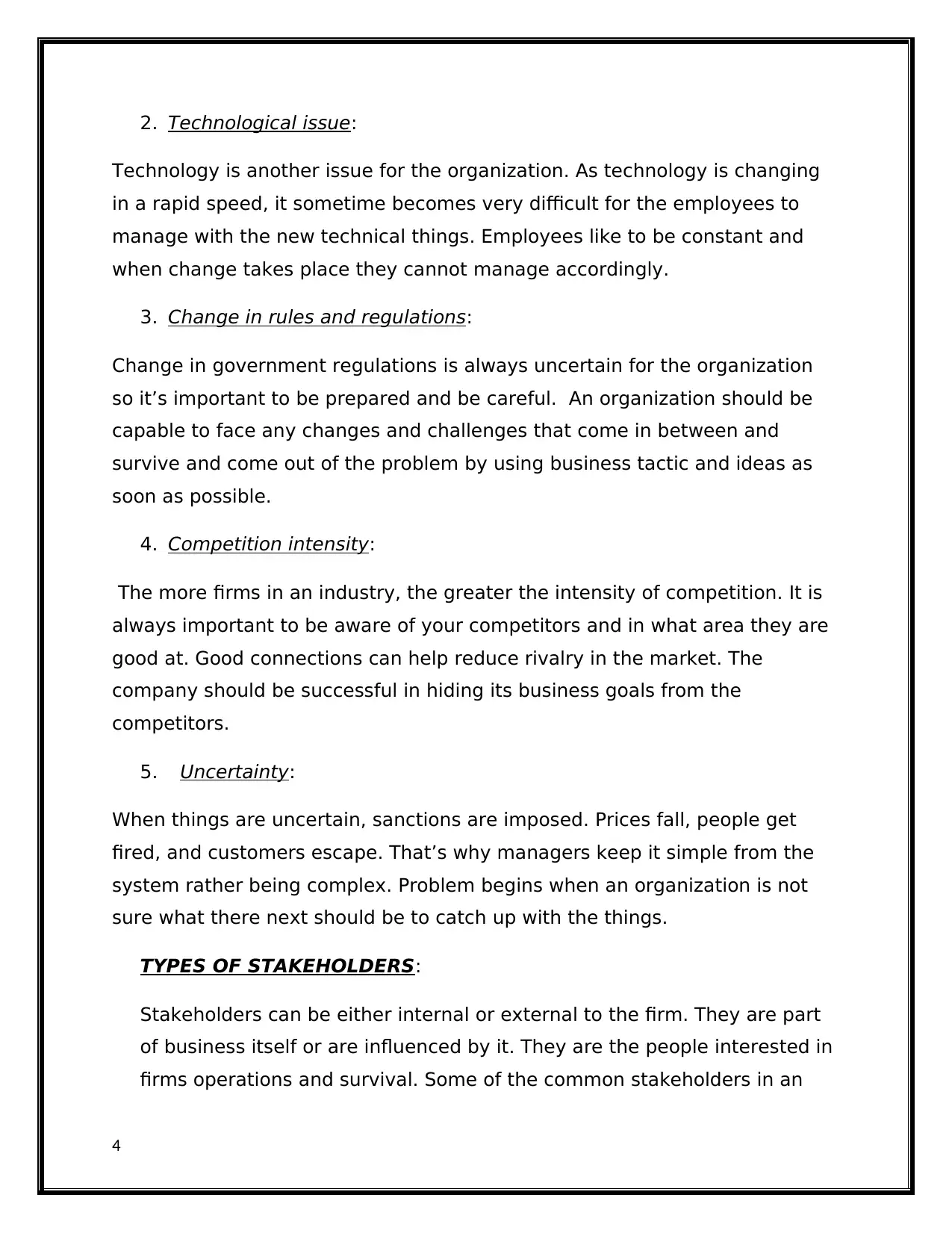
2. Technological issue:
Technology is another issue for the organization. As technology is changing
in a rapid speed, it sometime becomes very difficult for the employees to
manage with the new technical things. Employees like to be constant and
when change takes place they cannot manage accordingly.
3. Change in rules and regulations:
Change in government regulations is always uncertain for the organization
so it’s important to be prepared and be careful. An organization should be
capable to face any changes and challenges that come in between and
survive and come out of the problem by using business tactic and ideas as
soon as possible.
4. Competition intensity:
The more firms in an industry, the greater the intensity of competition. It is
always important to be aware of your competitors and in what area they are
good at. Good connections can help reduce rivalry in the market. The
company should be successful in hiding its business goals from the
competitors.
5. Uncertainty:
When things are uncertain, sanctions are imposed. Prices fall, people get
fired, and customers escape. That’s why managers keep it simple from the
system rather being complex. Problem begins when an organization is not
sure what there next should be to catch up with the things.
TYPES OF STAKEHOLDERS:
Stakeholders can be either internal or external to the firm. They are part
of business itself or are influenced by it. They are the people interested in
firms operations and survival. Some of the common stakeholders in an
4
Technology is another issue for the organization. As technology is changing
in a rapid speed, it sometime becomes very difficult for the employees to
manage with the new technical things. Employees like to be constant and
when change takes place they cannot manage accordingly.
3. Change in rules and regulations:
Change in government regulations is always uncertain for the organization
so it’s important to be prepared and be careful. An organization should be
capable to face any changes and challenges that come in between and
survive and come out of the problem by using business tactic and ideas as
soon as possible.
4. Competition intensity:
The more firms in an industry, the greater the intensity of competition. It is
always important to be aware of your competitors and in what area they are
good at. Good connections can help reduce rivalry in the market. The
company should be successful in hiding its business goals from the
competitors.
5. Uncertainty:
When things are uncertain, sanctions are imposed. Prices fall, people get
fired, and customers escape. That’s why managers keep it simple from the
system rather being complex. Problem begins when an organization is not
sure what there next should be to catch up with the things.
TYPES OF STAKEHOLDERS:
Stakeholders can be either internal or external to the firm. They are part
of business itself or are influenced by it. They are the people interested in
firms operations and survival. Some of the common stakeholders in an
4
Paraphrase This Document
Need a fresh take? Get an instant paraphrase of this document with our AI Paraphraser
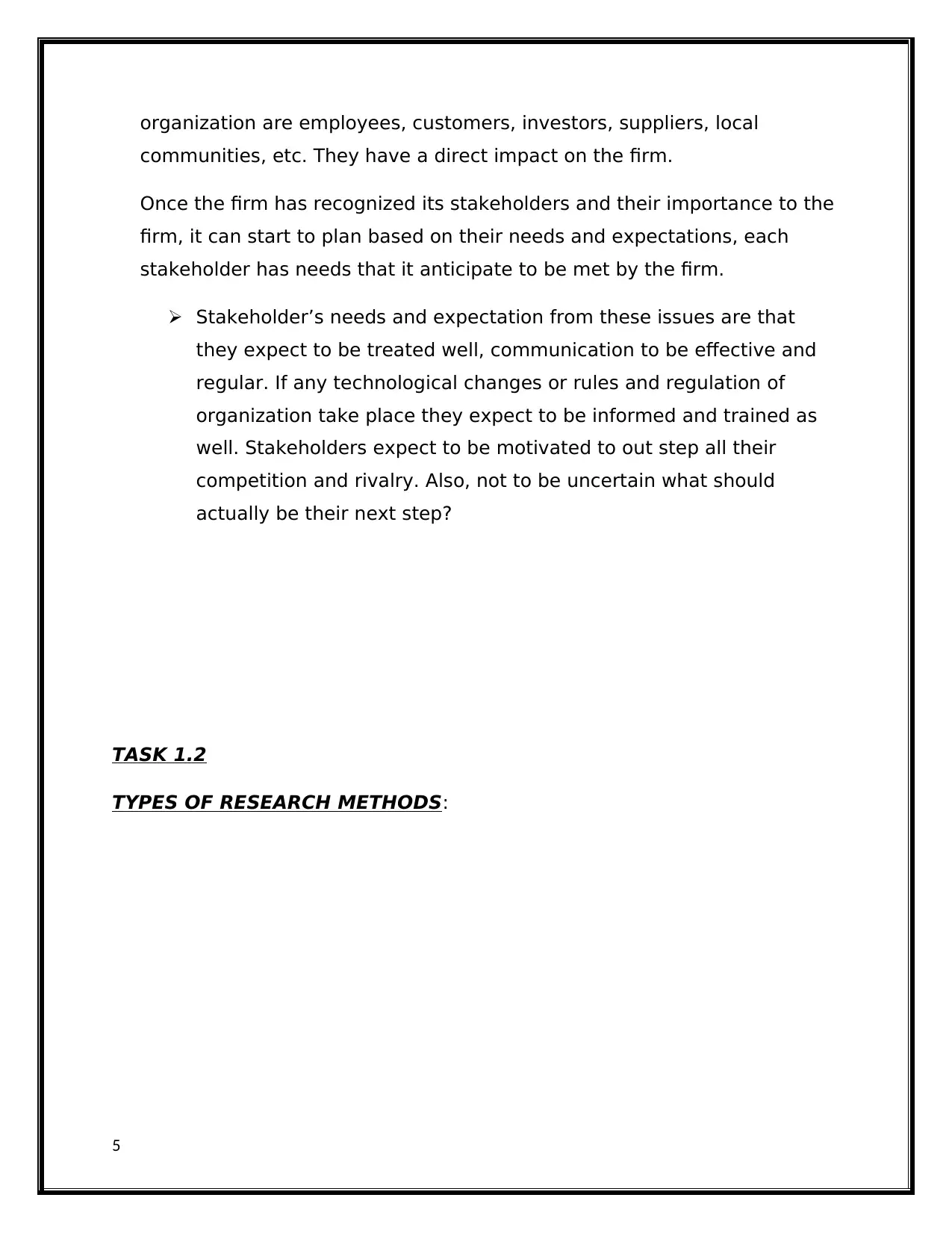
organization are employees, customers, investors, suppliers, local
communities, etc. They have a direct impact on the firm.
Once the firm has recognized its stakeholders and their importance to the
firm, it can start to plan based on their needs and expectations, each
stakeholder has needs that it anticipate to be met by the firm.
Stakeholder’s needs and expectation from these issues are that
they expect to be treated well, communication to be effective and
regular. If any technological changes or rules and regulation of
organization take place they expect to be informed and trained as
well. Stakeholders expect to be motivated to out step all their
competition and rivalry. Also, not to be uncertain what should
actually be their next step?
TASK 1.2
TYPES OF RESEARCH METHODS:
5
communities, etc. They have a direct impact on the firm.
Once the firm has recognized its stakeholders and their importance to the
firm, it can start to plan based on their needs and expectations, each
stakeholder has needs that it anticipate to be met by the firm.
Stakeholder’s needs and expectation from these issues are that
they expect to be treated well, communication to be effective and
regular. If any technological changes or rules and regulation of
organization take place they expect to be informed and trained as
well. Stakeholders expect to be motivated to out step all their
competition and rivalry. Also, not to be uncertain what should
actually be their next step?
TASK 1.2
TYPES OF RESEARCH METHODS:
5
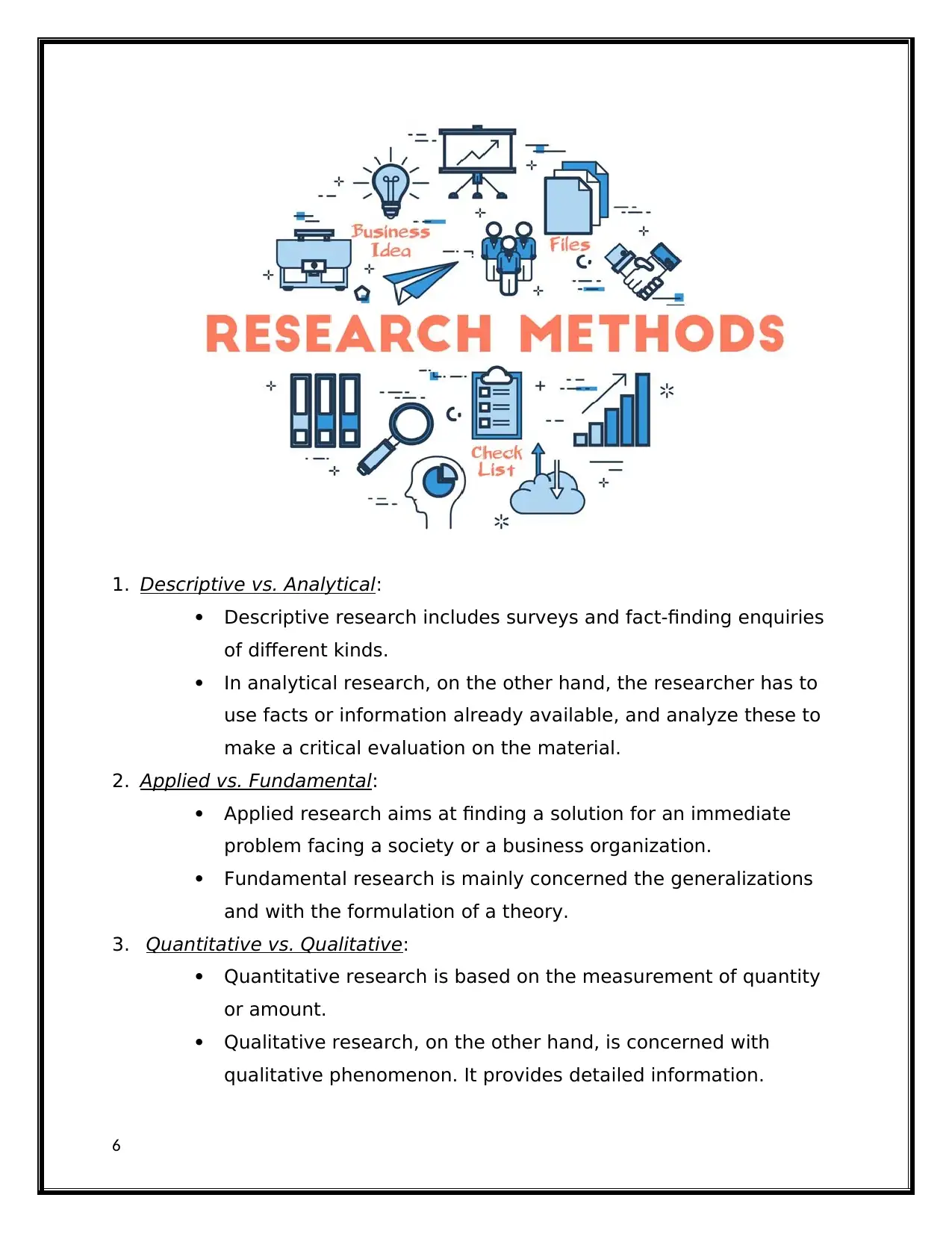
1. Descriptive vs. Analytical:
Descriptive research includes surveys and fact-finding enquiries
of different kinds.
In analytical research, on the other hand, the researcher has to
use facts or information already available, and analyze these to
make a critical evaluation on the material.
2. Applied vs. Fundamental:
Applied research aims at finding a solution for an immediate
problem facing a society or a business organization.
Fundamental research is mainly concerned the generalizations
and with the formulation of a theory.
3. Quantitative vs. Qualitative:
Quantitative research is based on the measurement of quantity
or amount.
Qualitative research, on the other hand, is concerned with
qualitative phenomenon. It provides detailed information.
6
Descriptive research includes surveys and fact-finding enquiries
of different kinds.
In analytical research, on the other hand, the researcher has to
use facts or information already available, and analyze these to
make a critical evaluation on the material.
2. Applied vs. Fundamental:
Applied research aims at finding a solution for an immediate
problem facing a society or a business organization.
Fundamental research is mainly concerned the generalizations
and with the formulation of a theory.
3. Quantitative vs. Qualitative:
Quantitative research is based on the measurement of quantity
or amount.
Qualitative research, on the other hand, is concerned with
qualitative phenomenon. It provides detailed information.
6
⊘ This is a preview!⊘
Do you want full access?
Subscribe today to unlock all pages.

Trusted by 1+ million students worldwide
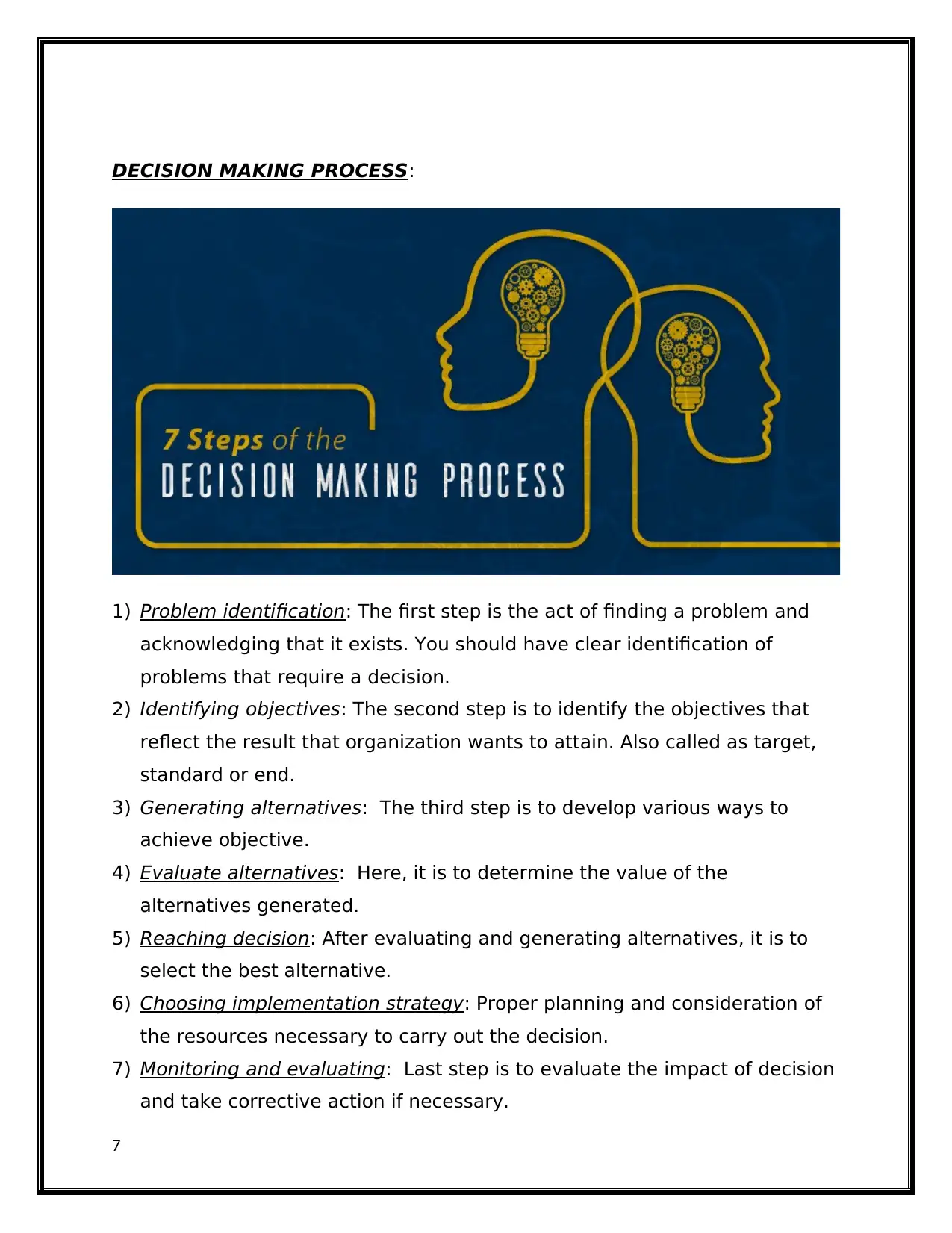
DECISION MAKING PROCESS:
1) Problem identification: The first step is the act of finding a problem and
acknowledging that it exists. You should have clear identification of
problems that require a decision.
2) Identifying objectives: The second step is to identify the objectives that
reflect the result that organization wants to attain. Also called as target,
standard or end.
3) Generating alternatives: The third step is to develop various ways to
achieve objective.
4) Evaluate alternatives: Here, it is to determine the value of the
alternatives generated.
5) Reaching decision: After evaluating and generating alternatives, it is to
select the best alternative.
6) Choosing implementation strategy: Proper planning and consideration of
the resources necessary to carry out the decision.
7) Monitoring and evaluating: Last step is to evaluate the impact of decision
and take corrective action if necessary.
7
1) Problem identification: The first step is the act of finding a problem and
acknowledging that it exists. You should have clear identification of
problems that require a decision.
2) Identifying objectives: The second step is to identify the objectives that
reflect the result that organization wants to attain. Also called as target,
standard or end.
3) Generating alternatives: The third step is to develop various ways to
achieve objective.
4) Evaluate alternatives: Here, it is to determine the value of the
alternatives generated.
5) Reaching decision: After evaluating and generating alternatives, it is to
select the best alternative.
6) Choosing implementation strategy: Proper planning and consideration of
the resources necessary to carry out the decision.
7) Monitoring and evaluating: Last step is to evaluate the impact of decision
and take corrective action if necessary.
7
Paraphrase This Document
Need a fresh take? Get an instant paraphrase of this document with our AI Paraphraser
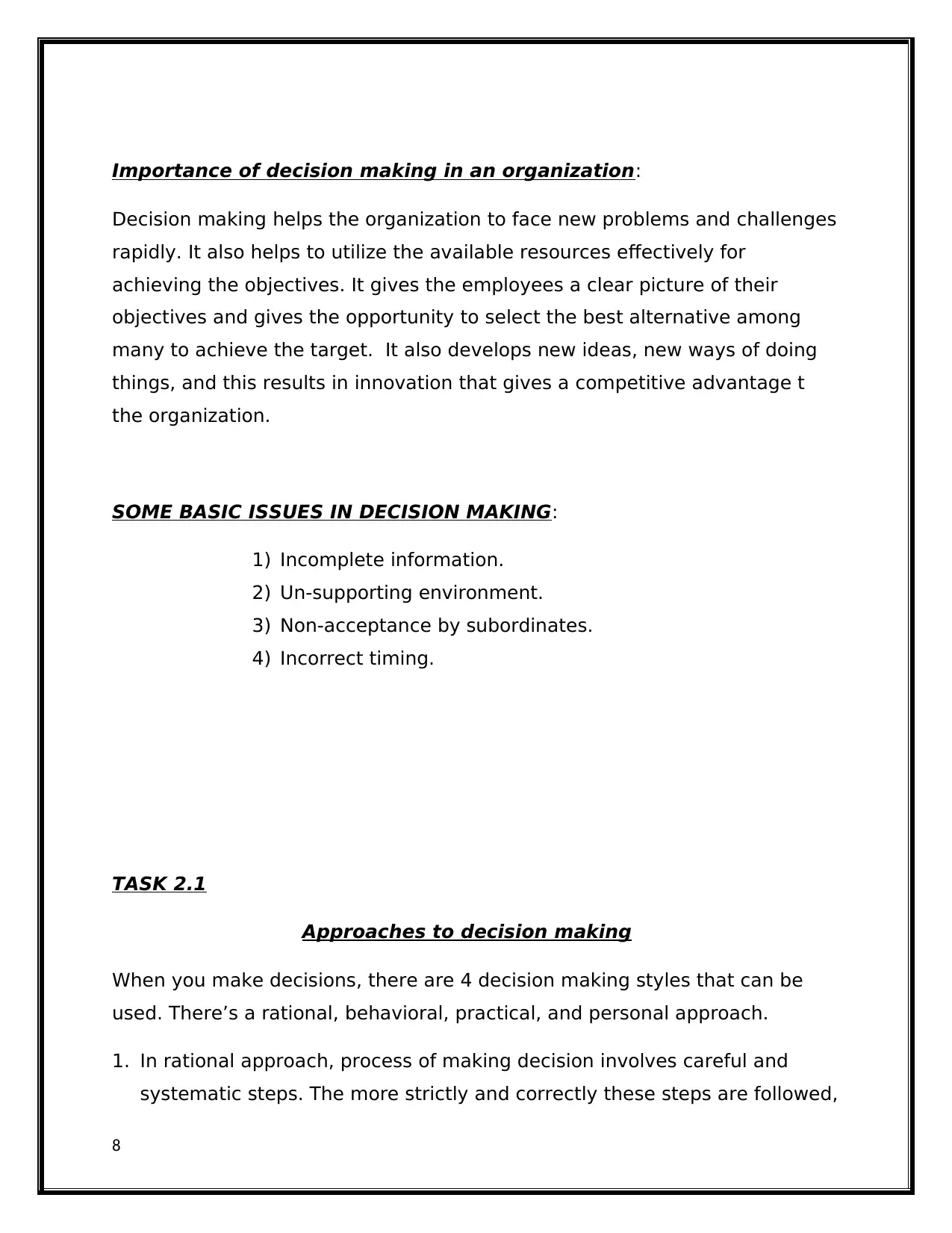
Importance of decision making in an organization:
Decision making helps the organization to face new problems and challenges
rapidly. It also helps to utilize the available resources effectively for
achieving the objectives. It gives the employees a clear picture of their
objectives and gives the opportunity to select the best alternative among
many to achieve the target. It also develops new ideas, new ways of doing
things, and this results in innovation that gives a competitive advantage t
the organization.
SOME BASIC ISSUES IN DECISION MAKING:
1) Incomplete information.
2) Un-supporting environment.
3) Non-acceptance by subordinates.
4) Incorrect timing.
TASK 2.1
Approaches to decision making
When you make decisions, there are 4 decision making styles that can be
used. There’s a rational, behavioral, practical, and personal approach.
1. In rational approach, process of making decision involves careful and
systematic steps. The more strictly and correctly these steps are followed,
8
Decision making helps the organization to face new problems and challenges
rapidly. It also helps to utilize the available resources effectively for
achieving the objectives. It gives the employees a clear picture of their
objectives and gives the opportunity to select the best alternative among
many to achieve the target. It also develops new ideas, new ways of doing
things, and this results in innovation that gives a competitive advantage t
the organization.
SOME BASIC ISSUES IN DECISION MAKING:
1) Incomplete information.
2) Un-supporting environment.
3) Non-acceptance by subordinates.
4) Incorrect timing.
TASK 2.1
Approaches to decision making
When you make decisions, there are 4 decision making styles that can be
used. There’s a rational, behavioral, practical, and personal approach.
1. In rational approach, process of making decision involves careful and
systematic steps. The more strictly and correctly these steps are followed,
8
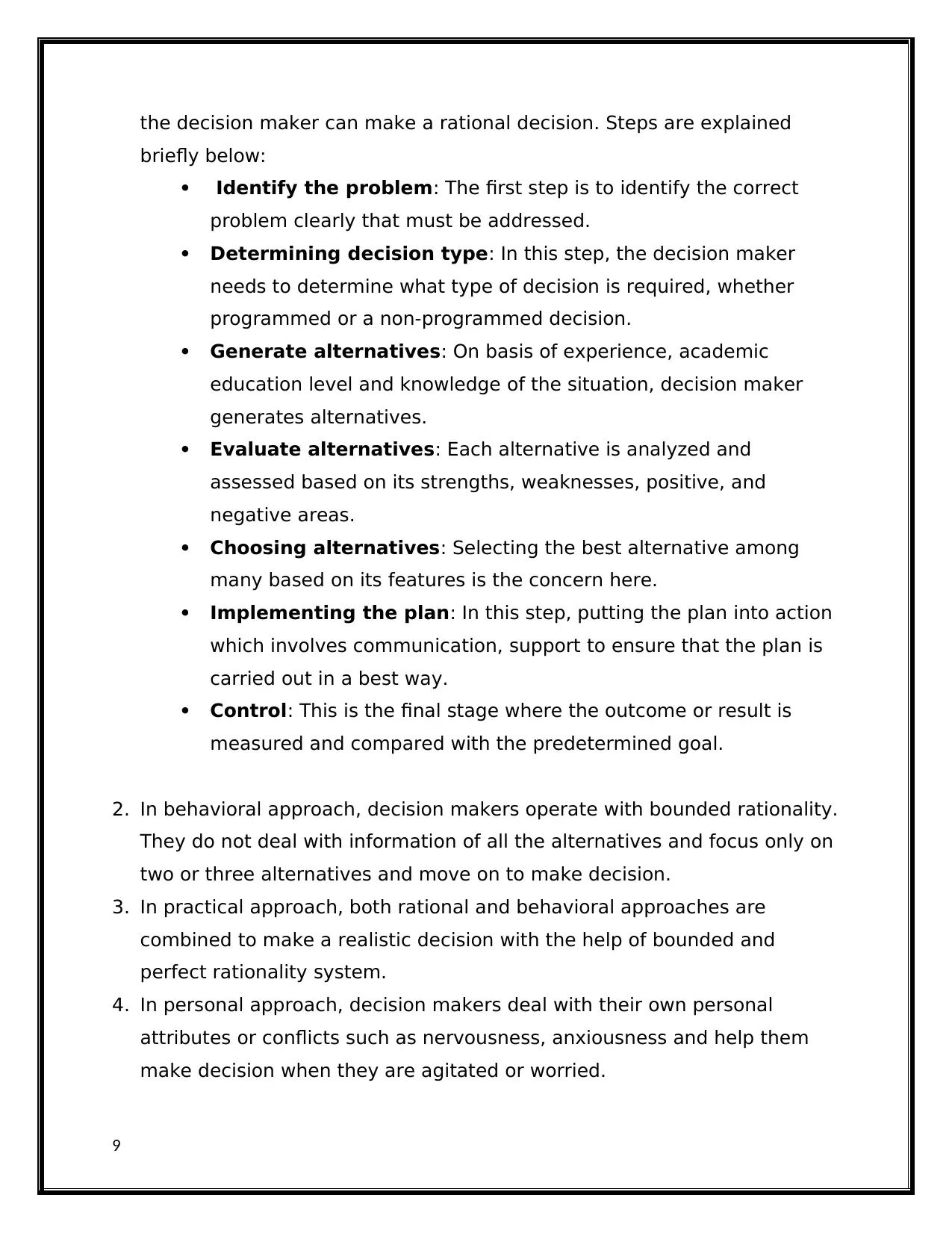
the decision maker can make a rational decision. Steps are explained
briefly below:
Identify the problem: The first step is to identify the correct
problem clearly that must be addressed.
Determining decision type: In this step, the decision maker
needs to determine what type of decision is required, whether
programmed or a non-programmed decision.
Generate alternatives: On basis of experience, academic
education level and knowledge of the situation, decision maker
generates alternatives.
Evaluate alternatives: Each alternative is analyzed and
assessed based on its strengths, weaknesses, positive, and
negative areas.
Choosing alternatives: Selecting the best alternative among
many based on its features is the concern here.
Implementing the plan: In this step, putting the plan into action
which involves communication, support to ensure that the plan is
carried out in a best way.
Control: This is the final stage where the outcome or result is
measured and compared with the predetermined goal.
2. In behavioral approach, decision makers operate with bounded rationality.
They do not deal with information of all the alternatives and focus only on
two or three alternatives and move on to make decision.
3. In practical approach, both rational and behavioral approaches are
combined to make a realistic decision with the help of bounded and
perfect rationality system.
4. In personal approach, decision makers deal with their own personal
attributes or conflicts such as nervousness, anxiousness and help them
make decision when they are agitated or worried.
9
briefly below:
Identify the problem: The first step is to identify the correct
problem clearly that must be addressed.
Determining decision type: In this step, the decision maker
needs to determine what type of decision is required, whether
programmed or a non-programmed decision.
Generate alternatives: On basis of experience, academic
education level and knowledge of the situation, decision maker
generates alternatives.
Evaluate alternatives: Each alternative is analyzed and
assessed based on its strengths, weaknesses, positive, and
negative areas.
Choosing alternatives: Selecting the best alternative among
many based on its features is the concern here.
Implementing the plan: In this step, putting the plan into action
which involves communication, support to ensure that the plan is
carried out in a best way.
Control: This is the final stage where the outcome or result is
measured and compared with the predetermined goal.
2. In behavioral approach, decision makers operate with bounded rationality.
They do not deal with information of all the alternatives and focus only on
two or three alternatives and move on to make decision.
3. In practical approach, both rational and behavioral approaches are
combined to make a realistic decision with the help of bounded and
perfect rationality system.
4. In personal approach, decision makers deal with their own personal
attributes or conflicts such as nervousness, anxiousness and help them
make decision when they are agitated or worried.
9
⊘ This is a preview!⊘
Do you want full access?
Subscribe today to unlock all pages.

Trusted by 1+ million students worldwide
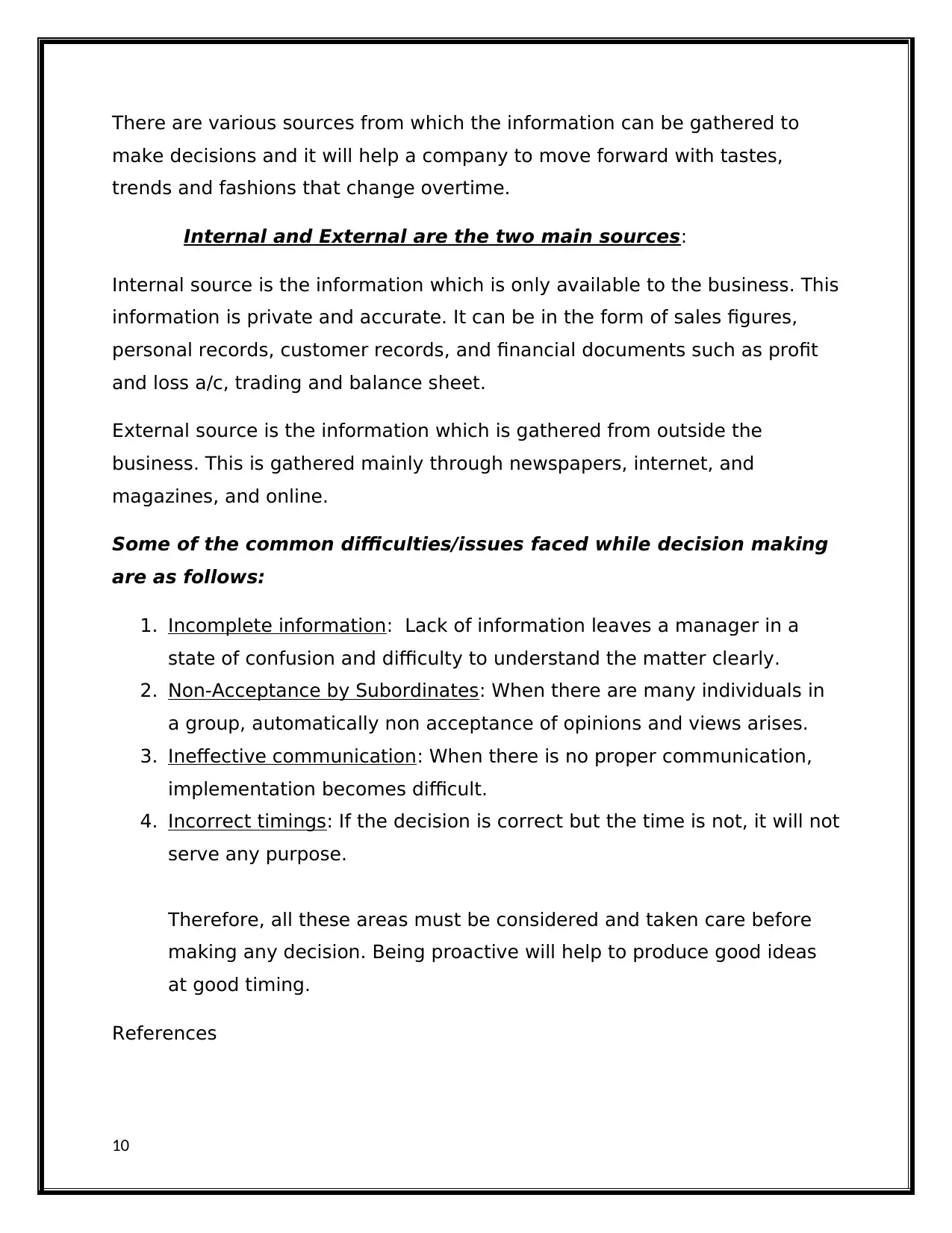
There are various sources from which the information can be gathered to
make decisions and it will help a company to move forward with tastes,
trends and fashions that change overtime.
Internal and External are the two main sources:
Internal source is the information which is only available to the business. This
information is private and accurate. It can be in the form of sales figures,
personal records, customer records, and financial documents such as profit
and loss a/c, trading and balance sheet.
External source is the information which is gathered from outside the
business. This is gathered mainly through newspapers, internet, and
magazines, and online.
Some of the common difficulties/issues faced while decision making
are as follows:
1. Incomplete information: Lack of information leaves a manager in a
state of confusion and difficulty to understand the matter clearly.
2. Non-Acceptance by Subordinates: When there are many individuals in
a group, automatically non acceptance of opinions and views arises.
3. Ineffective communication: When there is no proper communication,
implementation becomes difficult.
4. Incorrect timings: If the decision is correct but the time is not, it will not
serve any purpose.
Therefore, all these areas must be considered and taken care before
making any decision. Being proactive will help to produce good ideas
at good timing.
References
10
make decisions and it will help a company to move forward with tastes,
trends and fashions that change overtime.
Internal and External are the two main sources:
Internal source is the information which is only available to the business. This
information is private and accurate. It can be in the form of sales figures,
personal records, customer records, and financial documents such as profit
and loss a/c, trading and balance sheet.
External source is the information which is gathered from outside the
business. This is gathered mainly through newspapers, internet, and
magazines, and online.
Some of the common difficulties/issues faced while decision making
are as follows:
1. Incomplete information: Lack of information leaves a manager in a
state of confusion and difficulty to understand the matter clearly.
2. Non-Acceptance by Subordinates: When there are many individuals in
a group, automatically non acceptance of opinions and views arises.
3. Ineffective communication: When there is no proper communication,
implementation becomes difficult.
4. Incorrect timings: If the decision is correct but the time is not, it will not
serve any purpose.
Therefore, all these areas must be considered and taken care before
making any decision. Being proactive will help to produce good ideas
at good timing.
References
10
Paraphrase This Document
Need a fresh take? Get an instant paraphrase of this document with our AI Paraphraser
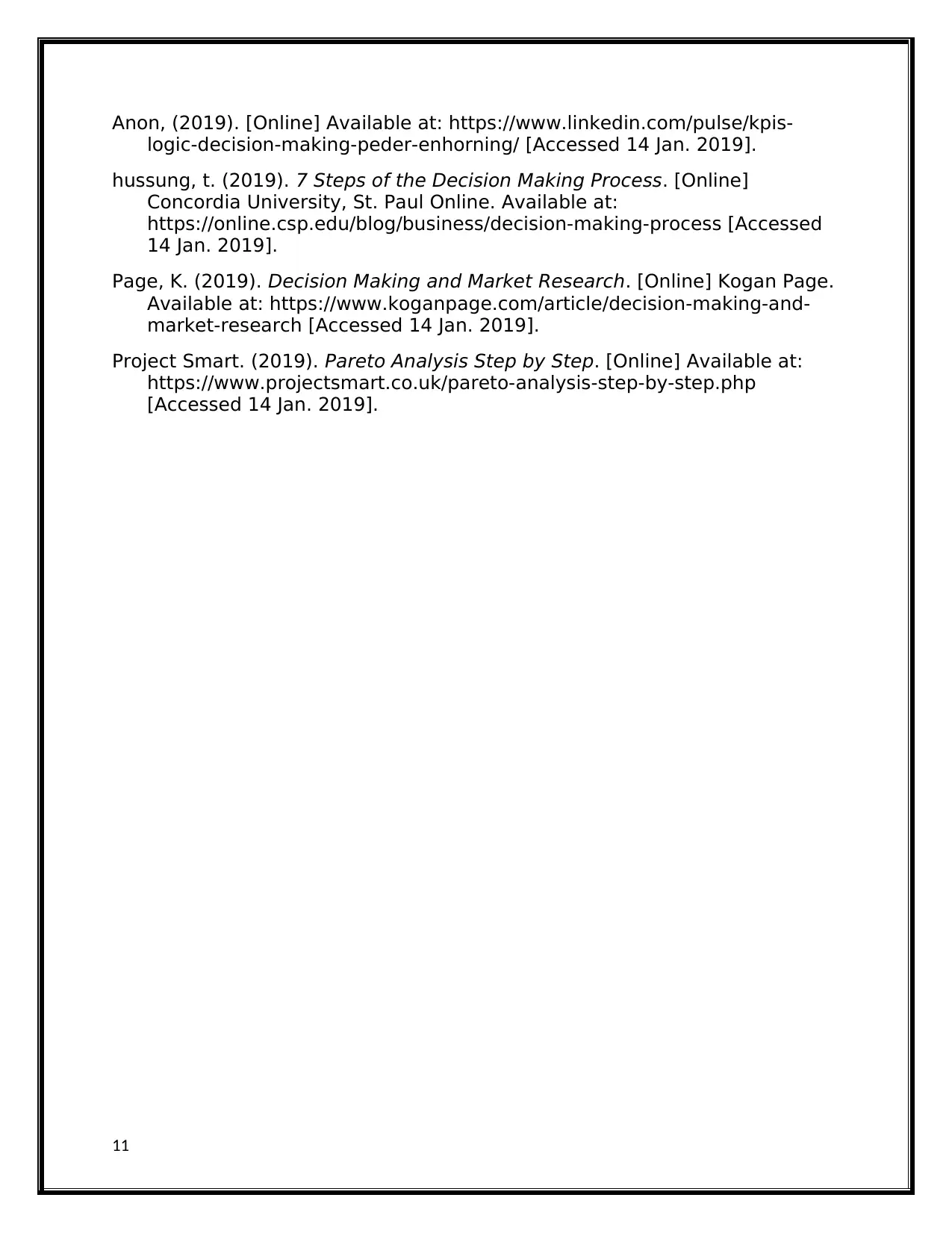
Anon, (2019). [Online] Available at: https://www.linkedin.com/pulse/kpis-
logic-decision-making-peder-enhorning/ [Accessed 14 Jan. 2019].
hussung, t. (2019). 7 Steps of the Decision Making Process. [Online]
Concordia University, St. Paul Online. Available at:
https://online.csp.edu/blog/business/decision-making-process [Accessed
14 Jan. 2019].
Page, K. (2019). Decision Making and Market Research. [Online] Kogan Page.
Available at: https://www.koganpage.com/article/decision-making-and-
market-research [Accessed 14 Jan. 2019].
Project Smart. (2019). Pareto Analysis Step by Step. [Online] Available at:
https://www.projectsmart.co.uk/pareto-analysis-step-by-step.php
[Accessed 14 Jan. 2019].
11
logic-decision-making-peder-enhorning/ [Accessed 14 Jan. 2019].
hussung, t. (2019). 7 Steps of the Decision Making Process. [Online]
Concordia University, St. Paul Online. Available at:
https://online.csp.edu/blog/business/decision-making-process [Accessed
14 Jan. 2019].
Page, K. (2019). Decision Making and Market Research. [Online] Kogan Page.
Available at: https://www.koganpage.com/article/decision-making-and-
market-research [Accessed 14 Jan. 2019].
Project Smart. (2019). Pareto Analysis Step by Step. [Online] Available at:
https://www.projectsmart.co.uk/pareto-analysis-step-by-step.php
[Accessed 14 Jan. 2019].
11
1 out of 11
Related Documents
Your All-in-One AI-Powered Toolkit for Academic Success.
+13062052269
info@desklib.com
Available 24*7 on WhatsApp / Email
![[object Object]](/_next/static/media/star-bottom.7253800d.svg)
Unlock your academic potential
Copyright © 2020–2025 A2Z Services. All Rights Reserved. Developed and managed by ZUCOL.




